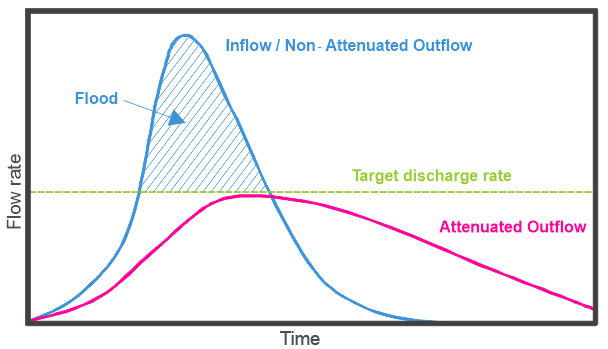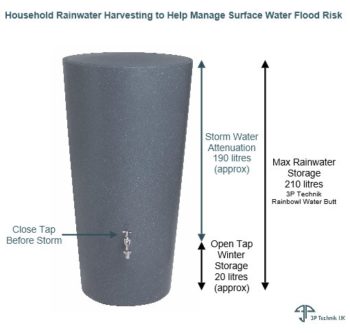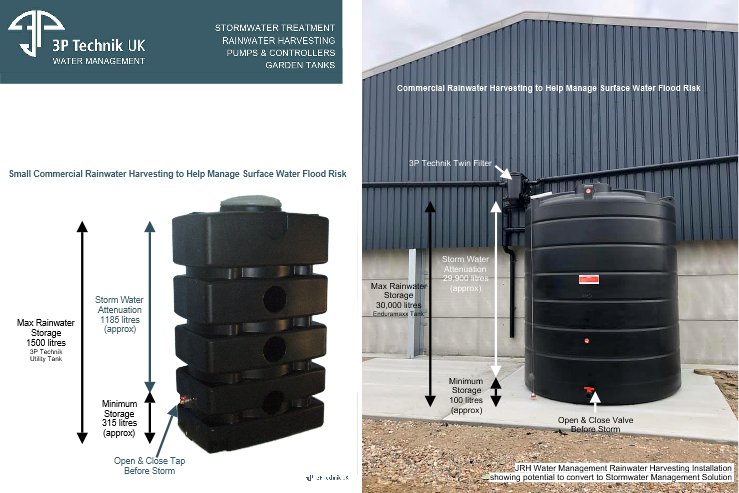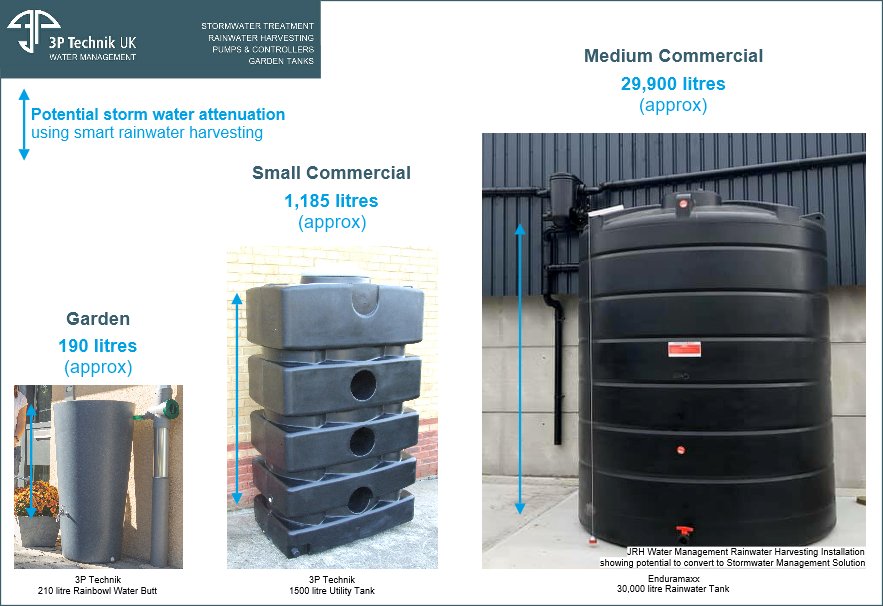How smart rainwater harvesting (with a water butt or large above-ground water tank) can play its part to slow the flow of stormwater and help prevent floods and in particular overflow from sewers.

Met Office image showing rainfall of 62mm in 24 hours in Tredegar in South Wales (Storm Dennis)
Floods are again making the news in the UK as Storm Ciara brought heavy rainfall to parts of the north and west just one week before Storm Dennis caused havoc too.
Storm Dennis is looking like a record breaking event. At its peak there were over 700 flood warnings and alerts in place across the UK. Many parts of the UK, for example Tredegar in South Wales, received as much rain in 24 hours as is more usual for an entire Winter month.
After a particularly wet autumn for some parts of the UK the land was already pretty saturated before the storms hit.
With Climate Change, the Met Office is predicting that UK winters will become warmer and wetter on average with heavy rainfall more likely.
We are all aware of the role of flood plains and the way that rainwater is discharged into streams and rivers over time (see Simple Hydrograph below). However, management of the entire rain water catchment area (that the flood plain collects water from) has not has been on the agenda until recent years.

Simple Hydrograph
Previously we have written about how farm scale attenuation ponds or reservoirs, which save winter rainfall for summer irrigation, can also help slow the flow of rainwater in storm events.
To help prevent floods in the long term, we need to think on a water catchment scale and encourage as many water management components as possible to create a sustainable solution.
Here we discuss what a household with a water butt can do to help slow the flow of rainwater and help prevent surface water flooding and in particular overflow from sewers. Co-ordinated community approaches through a Flood Action Group, for example, are of course ideal as they multiply the impact of individual flood mitigation actions by the number of participants of the scheme and encourage involvement by households above the flood zone (upstream) which of course is key to helping slow the flow of water to the homes that are more likely to flood.
Water Butts to create Mini Water Reservoirs
More often thought of as a way to save water during summer months to beat the hosepipe ban and water the garden, individuals can also help slow the flow of rainwater to help prevent flooding with their water butts too.
Nowadays water butts come in all shape, sizes and colours from elegant vases planters holding around 150 litres of water to square and sturdy wall tanks holding 800 litres. From our range, the most often installed water butts for UK homes have a capacity to hold around 250 litres. Water butts of this size tend to be of dimensions that fit in even the smallest gardens.
3P Technik has worked with many organisations who install water butts in communities that are prone to flooding. Several different solutions for mitigating surface water flooding with water butts have been trialled by different Action Groups. Solutions generally require a certain amount of awareness of future storm events and range from the simple to more technically complex.
Some simple solutions include deliberately creating “leaky butts” where the tap (or a mid-height “leaky pipe”) is left slightly open so that it drips water slowly into the drainage system.
More technical solutions to surface water flooding, called active rainwater harvesting, intelligent rainwater harvesting or smart rainwater harvesting usually require GSM mobile technology combined with weather data to automatically control the opening and closing of water tank valves before and after storm events.

Rainbowl Garden Water Butt to slow the flow of stormwater.
The simplest solution (something that everyone with a water butt can do) is to empty down the water butt during wetter winter months (garden plants rarely need watering during this time) and leave the water butt tap open until a storm event is predicted. Households then, when alerted, (either by the met office weather alert app, email or twitter ) can close the tap to allow the remaining storage capacity of water to be filled when it starts to rain. Water butts that sit on the ground and have a tap at a height where a watering can is easily filled (without having to raise the water butt) are ideal for this as the 30cm height of water that remains in the water butt also helps to weigh the water butt down in gusts of winds.
How much water will a water butt store to prevent surface water flood risk?
Using the 3P Technik Rainbowl style water butt, as shown above, as an example one single water butt could attenuate 190 litres of rainwater. That assumes that the water butt only has water to the height of the water butt tap before the storm arrives and that the tap is closed just before the storm is predicted to hit.
Multiplied by 1000 households that equates to a potential 190,000 litres (or 190 m3) of rainwater that are prevented from flooding the local environment. Of course, water butts can be much larger and more households can deploy this type of simple system. In both cases the amount of attenuated water will be much greater.
The more rainwater that is stored during a storm event, the more likely it is that local rivers can stay under the target discharge rate (as shown in the simple hydrograph above) and reduce or even prevent flooding, especially localised sewer flooding.
If every household with a garden does their bit to manage rainwater from their roofs it will add up to significant water storage capacity that will make a difference to mitigating flooding in many storm events. It is something that anyone with a water butt who is located within flood-prone catchment areas can think to do next time there is a storm on the horizon to help their downstream neighbours. With care and expertise, overflows can be diverted to ponds, swales or soakaways. This process of disconnecting from the main surface water system requires great care though. This is part of SUDS designs, and can be incorporated with rain gardens, swales, wildlife ponds and SUDS planters.
However, the massive regional and national storms that we have just witnessed with Storm Dennis require large schemes, including in some catchments major land-use changes to be implemented if we are to reduce the impact.
Smart Rainwater Harvesting Tanks to Slow the Flow of Stormwater and Prevent Floods

Commercial sized Smart Rainwater Harvesting Tanks for stormwater attenuation.
Clearly, buildings with larger roof areas, for example on industrial estates, farms and other commercial buildings can harvest more rainwater. Above ground water tanks vary in size from 1500 litres to 30,000 litres and can also be linked together to increase storage capacity. Many businesses are already installing rainwater tanks to help reduce their washdown and process water bills like the 30,000 litre example from JRH Water Management (pictured). Solutions like these not only collect rainwater, but because rainwater is “soft”, farmers in mains hard water areas have found that they can reduce the amount of water additives, conditioners and buffering agents they need to make equipment and chemicals work efficiently, by simply using rainwater instead.
With careful modification and discussion around planned business water use requirements on a daily/monthly basis, water companies or local authorities are well placed to manage storm water on a local or even at catchment scale. Rainwater Harvesting storage schemes linked to a central Control Point that is analysing regional weather patterns as a matter of routine anyway and is aware of the local storage and flooding capacities would be a powerful flood mitigation tool. Using technologies like GMS, the Central Point could prepare tanks for incoming storm events that present a flood risk. This could be as simple as opening a rainwater storage tank solenoid valve via a simple electronic controller before the storm (water diverted to drainage system or an attenuation pond) and then closing it in good time to capture and retain water during the intense storm rainfall. This system will attenuate the flow from all roofs connected to “Smart” Rainwater Tanks.
How much rainwater can farms and businesses on industrial estates store to prevent surface water flood risk?
One 30,000 litre rainwater tank could be drained down to almost empty, assuming no immediate business need for the rainwater. If water is required that day the retained level would need to be carefully pre-defined and the solenoid valve positioned at a height that is commercially viable. Assuming no business need, a single tank could attenuate approximately 29,900 litre of rain in a storm event. It is not unusual for commercial enterprises to install multiple tanks linked together when space allows like this example of eight 25,000 litre rainwater tanks at a chicken egg laying farm north Leicestershire.
If 100 businesses in a water sub-catchment area had on average two 30,000 litre tanks that each could be utilised for 29,000 litres it equates to 5,980,000 litres or (5,980m3) of rain that is prevented from running into the flood-prone drainage system at the critical moment. The benefits for individual industrial estates could be huge for a local Water Company with a spilling Combined Sewer Overflow (CSO).
3P Technik Director, Dr Glyn Hyett says, “Along with planting more trees and improving our soils, the need to Slow the Flow of rainfall during storm events in our urban areas too has never been greater”.
Working with Communities to Help Prevent Floods
The joy of working with 3P Technik UK for community flood prevention initiatives is that our catalogue of Water Butts has 18 different water butt designs in many different colours, so households find a water butt in our catalogue that they love. From 150 litres to 1500 litres, cylinder planters to space saving designer water butts in neutral colours all Water Butts are held in stock in the UK.
For larger rainwater harvesting projects, we work with UK Water Tank manufacturers and installers to provide solutions to commercial businesses, industrial estates and farms. Our industrial downpipe filters are suitable for roofs from 450m2 and upwards enabling flood prevention and water re-use solutions in one package. The VF1 Filter and Twin Filters are most often used on commercial rainwater harvesting systems.

Smart Rainwater Harvesting to play its part to prevent floods. Garden water butts to above-ground commercial systems.
